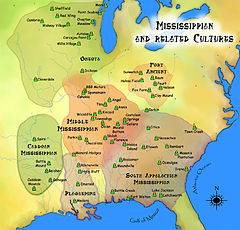- Nanatsoho
-
The Nanatsoho were a Native American tribe that lived at the border of Arkansas, Oklahoma, and Texas.[1]
Contents
History
The Nanatsoho were part of the Kadohadacho branch of the Caddo Confederacy. During the late 17th and early 18th centuries, they settled along the Great Bend of the Red River, in present day Bowie and Red River Counties.[2]
Henri Joutel, a French adventurer, was the first known European to contact the Nanatsoho in 1687.[3]
In 1719 French explorer Jean-Baptiste Bénard de la Harpe met Nanatsoho chiefs at a Nasoni village. On 7 April 1719, La Harpe arrived at their settlement on the north bank of the Red River in present day Oklahoma.[4] They lived between the Nasoni and Kadohadacho.[5] Their settlement near a ford, and Nanatsoho hunters have excellent access to buffalo, beaver, and black bear, near tributaries to the Red River.[6]
Ultimately, they assimilated into other Kadohadacho tribes in the 19th century.[2] They are enrolled in the Caddo Nation of Oklahoma today.
Synonymy
The tribe is also known as the Natsoho, Natsoo, Natsoto,[7] Nadsoo, Natsvto,[2] and Nathosos.[8]
Namesake
Nanatsoho Springs in Texas was named for this tribe.
Notes
References
- Carter, Cecile Elkins. Caddo Indians: Where We Come From. Norman: University of Oklahoma Press, 2001. ISBN 0-806-13318-X
- Sturtevant, William C., general editor and Raymond D. Fogelson, volume editor. Handbook of North American Indians: Southeast. Volume 14. Washington DC: Smithsonian Institution, 2004. ISBN 0-16-072300-0.
- Swanton, John Reed. Source material on the history and ethnology of the Caddo Indians. Norman: University of Oklahoma Press, 1996. ISBN 978-0806128566.
External links
- Nanatsoho Indians, from Handbook of Texas Online
Caddo Confederacy Hasinai Kadohadacho Natchitoches Other groups  Pre-Columbian North America
Pre-Columbian North AmericaArchaeological cultures North American pre-Columbian chronology – Adena – Alachua – Ancient Pueblo (Anasazi) – Baytown – Belle Glade – Buttermilk Creek Complex – Caborn-Welborn – Calf Creek – Caloosahatchee – Clovis – Coles Creek – Deptford – Folsom – Fort Ancient – Fort Walton – Fremont – Glades – Glacial Kame – Hopewell (List of Hopewell sites) – Hohokam – Leon-Jefferson – Mississippian (List of Mississippian sites) – Mogollon – Monongahela – Old Cordilleran – Oneota – Paleo-Arctic – Paleo-Indians – Patayan – Plano – Plaquemine – Poverty Point – Prehistoric Southwest – Red Ocher – Santa Rosa-Swift Creek – St. Johns – Steed-Kisker – Tchefuncte – Tocobaga – Troyville
Archaeological sites Angel Mounds – Bandelier National Monument – The Bluff Point Stoneworks – Cahokia – Chaco Canyon – Casa Grande – Coso Rock Art District – Eaker – Effigy Mounds National Monument – Etowah Indian Mounds – Eva – Folsom Site – Fort Ancient – Fort Center – Gila Cliff Dwellings National Monument – Holly Bluff Site – Hopewell Culture National Historical Park – Kincaid Mounds – Kolomoki – Manitou Cliff Dwellings – Marksville – Meadowcroft Rockshelter – Mesa Verde – Moorehead Circle – Moundville – Mummy Cave – Nodena Site – Ocmulgee National Monument – Old Stone Fort – Parkin Park – Pinson Mounds – Portsmouth Earthworks – Poverty Point – Pueblo Bonito – Rock Eagle – Rock Hawk – Salmon Ruins – Serpent Mound – Spiro Mounds – SunWatch – Taos Pueblo – Toltec Mounds – Town Creek Indian Mound – WintervilleMiscellaneous Ballgame – Black drink – Buhl woman – Calumet – Chunkey – Clovis point – Container Revolution – Eastern Agricultural Complex – Eden point – Effigy mound – Falcon dancer – Folsom point – Green Corn Ceremony – Horned Serpent – Kennewick man – Kiva – Metallurgy – Mi'kmaq hieroglyphic writing – Medicine wheel – Mound builders – N.A.G.P.R.A. – Norse colonization of the Americas – Piasa – Pueblo dwellings – Southeastern Ceremonial Complex – Three Sisters agriculture – Thunderbird – Underwater panther
Categories:- Caddoan peoples
- Native American tribes in Texas
- Native American history of Arkansas
- Native American history of Texas
Wikimedia Foundation. 2010.


